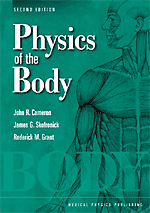
Physics of the Body 2nd E
Author: John Cameron et al.ISBN: 9780944838914 ISBN10: 094483891X
Published: 1999 | 394 pp | Softcover
Price: $ 45.95
SCOPE | December 2009
I enjoyed this book, which clearly shows how important and how varied the physics is behind the workings of the human body. The authors intend it for students who plan to make a career in some field of medicine but suggest it would also be of interest to anyone who is curious about how the body works. It would equally be of interest to a medical physics student interested in the physics (and physiology) of the human body, although with the exception of physiological measurement and possibly biomechanics, there is little of direct relevance to the IPEM training scheme. The math is at the algebra level, although some of the questions peppered through the book do require considerable thought.
The scope is wide, given that so many branches of physics are involved in the various body systems discussed. The book begins with an introduction to terminology, modelling and measurement. Each subsequent chapter covers a different body system and/or field of physics -- beginning with energy, heat and work, and continuing through to muscles and forces, the skeleton, pressure, osmosis and the kidneys. It also covers the pulmonary system, the cardiovascular system, electrical signals in the body, sound and speech, the ear and hearing, and the eye and vision.
The book covers not just the physics of the body, but also relevant physiology and pathology along with the physics of measurement techniques and devices. Each chapter contains questions to help the student check their understanding, and there is a separate answer book. A minor quibble relates to the practice of giving the answer (in brackets) immediately after the question -- this works well where a calculation is needed and a numerical answer can be quickly checked without turning to the worked example in the answer guide. However, for a descriptive answer, it gives too much away. In fact, in a couple of cases after listing the question and its bracketed answer, the answer guide simply notes that 'no further explanation is needed'. Not all chapters have this flaw and it may be that each of the three authors took a slightly different approach in the chapters they were responsible for.
The book is well written with clear explanations and there is no duplication of material. Almost every page has useful diagrams or images to illustrate the physics. There are also occasional personal anecdotes to liven up the text; for example one of the authors claims to be able to wiggle each ear independently, adding in a footnote: 'some people think this is his most outstanding accomplishment' -- somewhat modest given the solid textbook he has contributed to. The intended audience should find this book useful and illuminating.
Angela Cotton
Southampton University Hospitals NHS Trust
